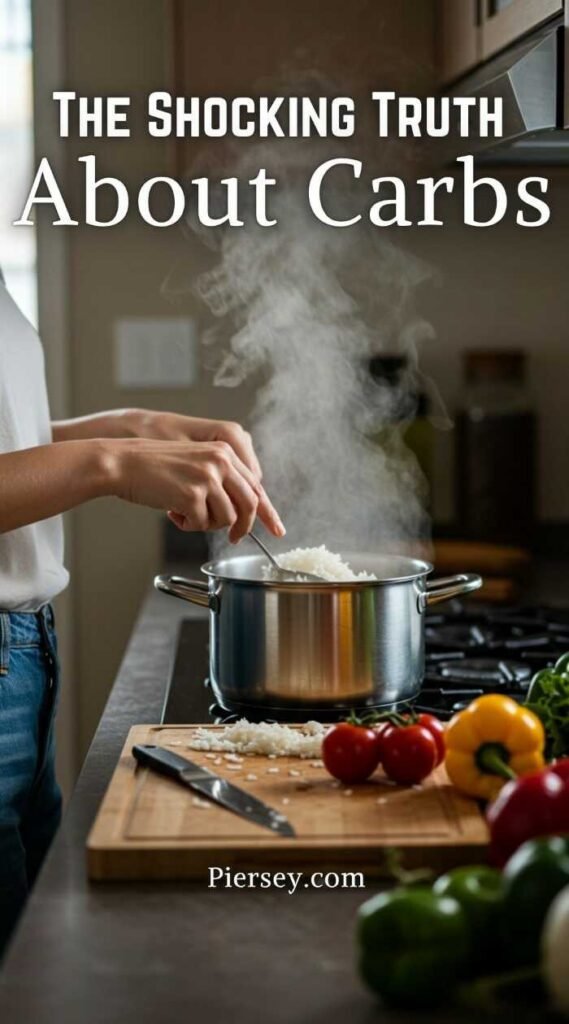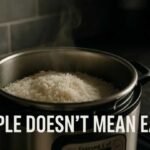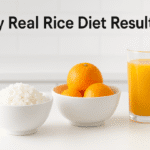Every time I tell someone I’m following the Rice Diet, their face does that look — you know the one. The mix of shock, curiosity, and concern that screams, “Wait… you eat what now?”
I’ve heard it all.
“You’ll waste away without protein!”
“You’re just eating carbs — enjoy diabetes!”
“There’s no way that’s sustainable!”
And honestly? I get it. If you only hear “rice and juice,” it sounds like punishment disguised as nutrition. But here’s the truth: I’m eating over 2,000 calories a day, I’m losing weight steadily, my energy is consistent, and my grocery bill looks like it time-travelled from 2005.
But for everyone else who wants to know why this works — and why it’s not as crazy as it sounds — let’s bust the most common Rice Diet myths I’ve heard since starting this journey.
👇 If you’d rather watch me explain it , the full video is right below 👇
Myth #1 — You’ll Waste Away Without Protein
This one’s my all-time favourite because it shows how misunderstood rice really is. People act like I’m eating oxygen with sauce.
Here’s the deal: I eat around six cups of cooked rice daily. That alone gives me roughly 32 grams of protein — and that’s before adding lentils, fruit, and the occasional veggie. That’s not “zero.” That’s a decent foundation.
Am I training for a bodybuilding competition? No. I’m rebuilding after years of weight gain, spine surgery, and inflammation issues. My focus right now is healing and fat loss, not chasing biceps.
But even so, protein isn’t the issue people think it is. Rice contains all nine essential amino acids — just not in huge amounts. When you mix it with other plant foods, it adds up. And when you’re eating enough calories (which I am), your body gets what it needs.
What fascinates me most is that Dr. Walter Kempner — the man who created this diet in the 1930s — was reversing obesity, diabetes, and kidney disease decades before protein powder was even invented. His patients didn’t shrivel up. They thrived.
I’m following a modern, plant-based version of his work — similar to what I did when I tested it for a month and dropped 19 pounds (you can read that breakdown in I Tried the Rice Diet for 1 Month (Lost 19 Pounds)).


Myth #2 — You Can’t Get Enough Nutrients
This one makes me laugh because people assume “simple” equals “nutrient-deficient.” But simplicity doesn’t mean starvation.
Let’s be real — I’m not pretending a bowl of rice has every vitamin ever discovered. That’s why I’m layering in foods that complement it:
- Orange juice for vitamin C and glucose support.
- Fruit and lentils for fiber, potassium, and protein.
- Occasional broccoli or greens for micronutrients and liver health.
And because we live in modern times, supplements exist. I’m not in a 1930s research clinic surviving on white rice and prayer. If I notice something slipping, I’ll fix it.
The funny part? Mentally and physically, I feel clearer now than I did on my old diets. When I was deep into keto and carnivore, I had constant fatigue and mood swings. Ironically, cutting meat and oil has made me less sluggish.
I’ve learned that food doesn’t have to be perfect — it just has to serve a purpose. And right now, that purpose is resetting my health.
(I wrote more about this idea of finding what really fits you long-term in Dieting Doesn’t Work (Do This Instead) — it’s all about ditching perfection and finding consistency instead.)
Myth #3 — It’s Not Sustainable
This one always comes from people who can’t imagine eating the same thing twice.
Here’s the truth: sustainability doesn’t mean endless options — it means something you can actually keep doing.
When I was on keto, I spent half my life meal-planning, counting macros, and stressing about whether I’d accidentally eaten 2g too many carbs. That’s not sustainable. That’s obsession.
Now, my meals are predictable and peaceful. Rice, juice, coffee, water, repeat. I don’t have to think about it — and that’s the point. My brain finally gets a break from the constant “what should I eat next?” chatter.
I’m not saying everyone should live on rice. But if your goal is to break food addiction, simplify your nutrition, and focus on actual healing — this structure is gold.
(If you’ve ever struggled to stay consistent after losing weight, check out The Brutal Truth About Keeping Weight Off — it ties right into this mindset of building stability instead of relying on motivation.)
Myth #4 — Carbs Are the Enemy
This one makes me roll my eyes so hard I almost pull a muscle.
We’ve been told carbs are evil for so long that people genuinely believe eating fruit is dangerous. Yet entire cultures have lived on rice-based diets for centuries — without the obesity and disease epidemics we see now.
The truth? Carbs aren’t the villain. It’s the oils, fats, and processed junk we eat with them that cause chaos.
On this high-carb, low-fat plan, I’m eating around 90% carbs, 5% protein, and 5% fat — and my energy is stable all day. I’m not battling cravings. I don’t crash after meals. And for the first time in years, I’m not constantly thinking about food.
It’s almost funny — the diet that’s supposed to make me weak is the one that’s finally giving me balance.
My Current Phase: Adjusting and Experimenting
Right now, I’m in what I’d call the tweaking stage. I’ve started lifting weights again, so I’m experimenting with lentils and chickpeas to see how my recovery goes. My target is around 90–100g of protein daily, but it’s a juggling act when fat is capped at 5%.
It’s definitely not glamorous — I’ve spent more time Googling lentil amino acid profiles than I’d like to admit — but this kind of curiosity keeps it interesting.
And here’s the thing: the Rice Diet gives me the foundation. Everything else is customization.
The beauty of this plan isn’t in the flavor — it’s in the freedom. The mental clarity. The predictability. After years of fighting food addiction, “boring” feels like freedom.


So, Is the Rice Diet Healthy?
People still love to say it’s dangerous, extreme, or outdated. But I’ve lived both sides — the low-carb world of fatty meats and butter coffee, and now this ultra-simple plant-based setup. And you know what? I feel better here.
My liver doesn’t ache anymore. My weight is dropping. My energy’s stable. My anxiety around food is almost gone.
The Rice Diet isn’t perfect, but it’s practical — and that’s the difference. I don’t need perfect. I need peace.
Final Thoughts: Simplicity Isn’t Boring — It’s Freedom
Here’s the thing no one tells you: the biggest barrier to getting healthy isn’t the food itself — it’s the noise around it. The constant opinions, the rules, the diet wars.
This Rice Diet experiment has taught me something much bigger than how to eat rice without losing my mind — it’s shown me that food doesn’t have to be complicated to work.
Maybe we’ve all been chasing the wrong thing. Maybe it’s not about finding the “perfect” diet — maybe it’s about finding peace with food.
So yeah, this lifestyle isn’t glamorous. Nobody’s rushing to make “Rice Diet Aesthetic” TikToks. But it’s simple, sustainable, and it’s helping me rebuild my health from the inside out.
And if there’s one myth I’ll never stop busting, it’s that you need fancy food to change your life.
Sometimes, all it takes is a bag of rice and a little patience.




